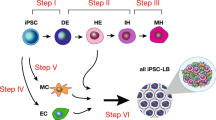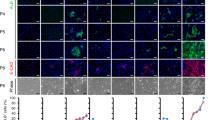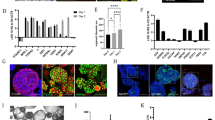Abstract
Generation of functional and vascularized organs from human induced pluripotent stem cells (iPSCs) will facilitate our understanding of human developmental biology and disease modeling, hopefully offering a drug-screening platform and providing novel therapies against end-stage organ failure. Here we describe a protocol for the in vitro generation of a 3D liver bud from human iPSC cultures and the monitoring of further hepatic maturation after transplantation at various ectopic sites. iPSC-derived specified hepatic cells are dissociated and suspended with endothelial cells and mesenchymal stem cells. These mixed cells are then plated onto a presolidified matrix, and they form a 3D spherical tissue mass termed a liver bud (iPSC-LB) in 1–2 d. To facilitate additional maturation, 4-d-old iPSC-LBs are transplanted in the immunodeficient mouse. Live imaging has identified functional blood perfusion into the preformed human vascular networks. Functional analyses show the appearance of multiple hepatic functions in a chronological manner in vivo.
This is a preview of subscription content, access via your institution
Access options
Subscribe to this journal
Receive 12 print issues and online access
$259.00 per year
only $21.58 per issue
Buy this article
- Purchase on Springer Link
- Instant access to full article PDF
Prices may be subject to local taxes which are calculated during checkout





Similar content being viewed by others
References
Liu, H., Kim, Y., Sharkis, S., Marchionni, L. & Jang, Y.Y. In vivo liver regeneration potential of human induced pluripotent stem cells from diverse origins. Sci. Transl. Med. 3, 82ra39 (2011).
Punch, J.D., Hayes, D.H., LaPorte, F.B., McBride, V. & Seely, M.S. Organ donation and utilization in the United States, 1996–2005. Am. J. Transplant. 7, 1327–1338 (2007).
Takahashi, K. et al. Induction of pluripotent stem cells from adult human fibroblasts by defined factors. Cell 131, 861–872 (2007).
Sasai, Y. Next-generation regenerative medicine: organogenesis from stem cells in 3D culture. Cell Stem Cell 12, 520–530 (2013).
Sekiya, S. & Suzuki, A. Direct conversion of mouse fibroblasts to hepatocyte-like cells by defined factors. Nature 475, 390–393 (2011).
Si-Tayeb, K. et al. Highly efficient generation of human hepatocyte-like cells from induced pluripotent stem cells. Hepatology 51, 297–305 (2010).
Cai, J. et al. Directed differentiation of human embryonic stem cells into functional hepatic cells. Hepatology 45, 1229–1239 (2007).
Kroon, E. et al. Pancreatic endoderm derived from human embryonic stem cells generates glucose-responsive insulin-secreting cells in vivo. Nat. Biotechnol. 26, 443–452 (2008).
Kriks, S. et al. Dopamine neurons derived from human ES cells efficiently engraft in animal models of Parkinson's disease. Nature 480, 547–551 (2011).
Kobayashi, T. et al. Generation of rat pancreas in mouse by interspecific blastocyst injection of pluripotent stem cells. Cell 142, 787–799 (2010).
Si-Tayeb, K., Lemaigre, F.P. & Duncan, S.A. Organogenesis and development of the liver. Dev. Cell 18, 175–189 (2010).
Matsumoto, K., Yoshitomi, H., Rossant, J. & Zaret, K.S. Liver organogenesis promoted by endothelial cells prior to vascular function. Science 294, 559–563 (2001).
Takebe, T. et al. Self-organization of human hepatic organoid by recapitulating organogenesis in vitro. Transplant. Proc. 44, 1018–1020 (2012).
Takebe, T. et al. Vascularized and functional human liver from an iPSC-derived organ bud transplant. Nature 499, 481–484 (2013).
Langer, R. & Vacanti, J.P. Tissue engineering. Science 260, 920–926 (1993).
Ott, H.C. et al. Perfusion-decellularized matrix: using nature's platform to engineer a bioartificial heart. Nat. Med. 14, 213–221 (2008).
Uygun, B.E. et al. Organ reengineering through development of a transplantable recellularized liver graft using decellularized liver matrix. Nat. Med. 16, 814–820 (2010).
Song, J.J. & Ott, H.C. Organ engineering based on decellularized matrix scaffolds. Trends Mol. Med. 17, 424–432 (2011).
Koike, N. et al. Tissue engineering: creation of long-lasting blood vessels. Nature 428, 138–139 (2004).
Takebe, T. et al. Generation of functional human vascular network. Transplant Proc. 44, 1130–1133 (2012).
Yang, G. et al. Thinned-skull cranial window technique for long-term imaging of the cortex in live mice. Nat. Protoc. 5, 201–208 (2010).
Xu, H.T. et al. Choice of cranial window type for in vivo imaging affects dendritic spine turnover in the cortex. Nat. Neurosci. 10, 549–551 (2007).
Zmuda, E.J. et al. A method for murine islet isolation and subcapsular kidney transplantation. J. Vis. Exp. 50, 2096 (2011).
Acknowledgements
We thank F. Kawamata, A. Takahashi, S. Funayama, N. Hijikata and N. Sasaki for kindly providing technical support, and Y.-W. Zheng, Y. Ueno and all of the members of our laboratory for help with several comments. We express our great thanks to Y. Sato, SAIKOU, Inc. for the illustrations for the protocols (http://www.medicalillustration.jp/). This work was supported by Grants-in-Aid of the Ministry of Education, Culture, Sports, Science, and Technology of Japan to T.T. (nos. 24106510, 24689052), N.K. (no. 22390260) and H.T. (nos. 21249071, 25253079). This work was also supported by grants to H.T. from the Research Center Network for Realization of Regenerative Medicine and the Strategic Promotion of Innovative Research and Development program (S-innovation, no. 62890004) of the JST; by a Specified Research Grant of the Takeda Science Foundation and a grant from the Japan IDDM network to H.T.; and by a grant of the Yokohama Foundation for Advanced Medical Science to T.T. K. Eto and H. Nakauchi (Institute of Medical Science, University of Tokyo) provided TkDA3 iPSCs.
Author information
Authors and Affiliations
Contributions
T.T. conceived, designed and conducted the experiments, analyzed the data and wrote the paper. R.-R.Z., H.K., M.K., E.Y. and M.E. performed experiments and wrote the paper. N.K., K.S. and H.T. supervised the project.
Corresponding authors
Ethics declarations
Competing interests
The authors declare no competing financial interests.
Supplementary information
Supplementary Video 1
Time-lapse imaging of human iPSC-LB formation process. (MOV 1112 kb)
Supplementary Video 2
Procedures for preparing a transparency cranial window. (MOV 4004 kb)
Supplementary Video 3
Procedures for transplantation under a cranial window. (MOV 3363 kb)
Supplementary Video 4
Procedures for transplantation under subrenal capsule. (MOV 4079 kb)
Supplementary Video 5
Procedures for transplantation onto distal mesentery. (MOV 2337 kb)
Supplementary Video 6
Procedures for transplantation onto proximal mesentery. (MOV 3414 kb)
Rights and permissions
About this article
Cite this article
Takebe, T., Zhang, RR., Koike, H. et al. Generation of a vascularized and functional human liver from an iPSC-derived organ bud transplant. Nat Protoc 9, 396–409 (2014). https://doi.org/10.1038/nprot.2014.020
Published:
Issue Date:
DOI: https://doi.org/10.1038/nprot.2014.020
This article is cited by
-
Cell therapy in end-stage liver disease: replace and remodel
Stem Cell Research & Therapy (2023)
-
Application of Induced Pluripotent Stem Cells in Malignant Solid Tumors
Stem Cell Reviews and Reports (2023)
-
Advances in liver organoids: model systems for liver disease
Archives of Pharmacal Research (2022)
-
Towards organoid culture without Matrigel
Communications Biology (2021)
-
An alternative approach to produce versatile retinal organoids with accelerated ganglion cell development
Scientific Reports (2021)
Comments
By submitting a comment you agree to abide by our Terms and Community Guidelines. If you find something abusive or that does not comply with our terms or guidelines please flag it as inappropriate.



